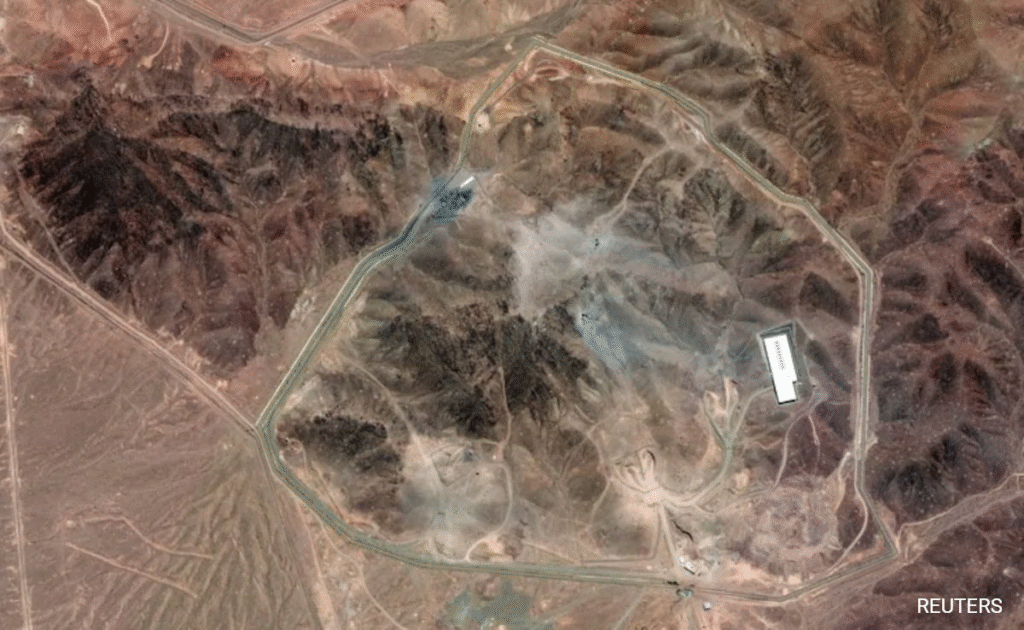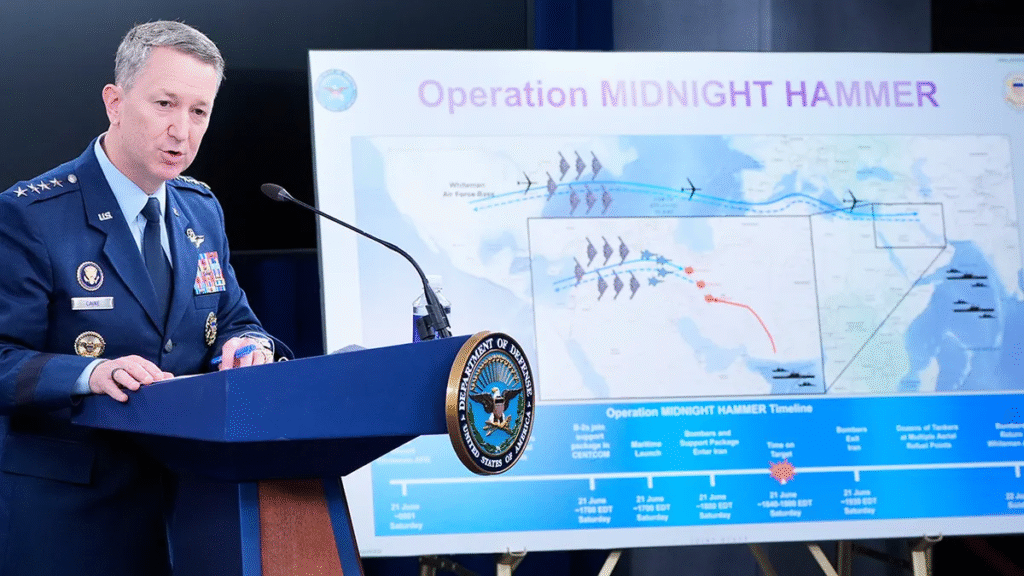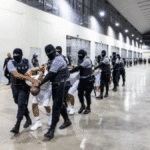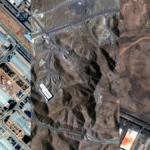Introduction
In a surprising disclosure during a Senate briefing, a top U.S. general revealed that bunker-buster bombs were not used in a recent strike associated with Operation Midnight Hammer—an operation widely believed to have targeted Iran’s Isfahan nuclear site. The decision, reportedly based on the depth of the facility, highlights the strategic restraint exercised by the U.S. military in a high-stakes region. This article explores the implications, technical challenges, and geopolitical context surrounding this revelation.
Understanding the Isfahan Nuclear Facility

Location and Strategic Significance
The Isfahan Nuclear Technology Center (INTC), located in central Iran, is a key hub in Iran’s nuclear fuel cycle. It includes:
- Uranium conversion facilities
- Research reactors
- Laboratories linked to enrichment programs
This site plays a crucial role in converting uranium yellowcake into uranium hexafluoride (UF6)—a gas essential for enrichment at facilities like Natanz.
Isfahan’s Role in Iran’s Nuclear Ambitions
Isfahan is not just symbolic—it’s operationally critical. Its capabilities feed Iran’s broader nuclear infrastructure, raising concerns among Western powers, particularly the U.S. and Israel. Its deep underground structure is designed to deter or survive aerial bombardment.
What Are Bunker-Buster Bombs?
Definition and Capabilities
Bunker-busters are specialized munitions designed to penetrate fortified underground facilities. The most advanced of these include:
- GBU-28: Developed during the Gulf War, it can burrow deep before detonation
- GBU-57A/B (MOP – Massive Ordnance Penetrator): A 30,000-pound bomb capable of reaching deeply buried targets
Intended Use
These weapons are used when adversaries harden or conceal facilities, such as:
- Missile silos
- Command centers
- Nuclear sites like Isfahan or Fordow
Their use often implies preparation for significant escalation.
Operation Midnight Hammer: What We Know

Overview of the Operation
Operation Midnight Hammer remains classified, but intelligence sources suggest it involved:
- Aerial surveillance
- Electronic warfare
- Precision strikes on Iranian infrastructure
It came amid rising tensions over Iran’s nuclear policy and regional activities.
Senate Hearing Bombshell
During a closed-door Senate Armed Services Committee session, a high-ranking U.S. general stated:
“Bunker-busters were not used on the Isfahan target… due to the facility’s depth and other strategic considerations.”
This contradicts early media reports suggesting that deep-strike munitions had been deployed.
Why Were Bunker-Busters Not Used?
Depth and Engineering Complexity
Military planners reportedly assessed that even the most advanced bunker-busters would not guarantee complete destruction of Isfahan’s underground layers without risk of surface-level collateral damage.
Diplomatic and Strategic Caution
Using bunker-busters could have:
- Signaled an imminent regime-change strategy
- Invited retaliation by Iranian proxies
- Provoked global condemnation
By holding back, the U.S. likely aimed to send a warning, not start a war.
Alternative Tactics Employed
Instead of bunker-busters, the U.S. may have used:
- Cyberattacks to disrupt operations
- Drone surveillance to collect data
- Decoy strikes to test Iran’s air defenses
These moves preserve deniability while asserting power.
Reactions to the Disclosure
Iranian Government Response
Iranian officials quickly labeled the operation “a hostile provocation”, but denied that any damage occurred. State-run media displayed photos of the Isfahan site fully intact.
Global Powers Weigh In
- Russia condemned the operation, calling it “reckless”
- Israel, while not confirming participation, praised the strategic pressure on Iran
- EU officials expressed concern, fearing the breakdown of the JCPOA (Iran Nuclear Deal) framework
Domestic U.S. Political Debate
Some U.S. senators criticized the decision not to use bunker-busters, arguing it shows weakness. Others commended the restraint as smart power in action.
Implications for Regional Security
Iran’s Military Calculus
Iran now knows the U.S. has targeted it without crossing key thresholds. This may:
- Push Iran to further fortify sites
- Accelerate nuclear development
- Spur proxy retaliation in Iraq, Syria, or Lebanon
U.S. Strategic Messaging
By avoiding maximal force, the U.S.:
- Avoided escalation
- Signaled it has options short of war
- Preserved space for diplomacy
It may also serve as a warning shot to Iran and others—like North Korea—without locking into full-scale conflict.
Israel’s Calculations
Israel, facing similar underground targets like Fordow, may question whether the U.S. would fully support an overt military strike. This could drive independent Israeli action.
Military Lessons Learned
Intelligence & Precision Matters
The operation underscores the need for:
- Deep-site intelligence
- Satellite thermographic analysis
- Subterranean facility mapping
Limited Use of Force Can Be Strategic
Military operations today often pursue non-destructive effects, like:
- Disruption over destruction
- Psychological deterrence
- Long-term pressure
This is modern hybrid warfare in action.
Could Future Strikes Use Bunker-Busters?
Scenario-Based Decisions
Bunker-busters remain an option if:
- Iran crosses a nuclear breakout threshold
- Diplomatic channels completely fail
- A direct attack is launched against U.S. or allied interests
In such cases, massive munitions could be justified under Article 51 of the UN Charter (self-defense).
Limitations and Risks
Even bunker-busters have risks:
- Incomplete penetration
- Civilian casualties if sites are near cities
- Political fallout from allied nations
Thus, their use remains a last resort.
Also Read : President Trump Says Israel-iran Ceasefire Is ‘now In Effect’
Conclusion
The revelation that bunker-busters were not used on Iran’s Isfahan nuclear site offers a rare glimpse into the delicate military-political calculus at play in U.S. foreign policy. Rather than a show of weakness, it likely reflects a calculated decision to apply pressure while preserving diplomatic pathways and regional stability.
In the shadow war over nuclear ambitions, sometimes the most powerful message is the one not delivered with a bomb.
Frequently Asked Questions (FAQs)
What is a bunker-buster bomb?
A bunker-buster is a type of bomb designed to penetrate hardened underground facilities, such as bunkers or nuclear sites, before detonating.
Why is the Isfahan nuclear site significant?
It plays a central role in Iran’s nuclear fuel cycle, especially in uranium conversion, which is a critical step before uranium enrichment.
What was Operation Midnight Hammer?
A classified military operation, believed to target Iranian nuclear and military infrastructure. It reportedly involved non-lethal disruption tactics without using deep-penetrating bombs.
Why did the U.S. avoid using bunker-busters?
Due to the depth of the target and the desire to avoid escalation, the U.S. chose alternative means to pressure Iran without full-scale military engagement.
Could Israel act independently?
Yes. Israel has previously signaled willingness to act unilaterally against Iranian nuclear sites if it believes the threat is imminent.
Was this operation a success?
That depends on the goal. If the aim was deterrence and disruption, not destruction, it may be considered a strategic success.
How has Iran responded?
Iran downplayed the impact, claimed its facilities were unharmed, and condemned the operation as an act of aggression.
Will this affect nuclear negotiations?
Possibly. It may harden Iran’s stance, but it also serves as a warning that military options remain on the table.
Are bunker-busters outdated?
No, but their use is constrained by political, legal, and tactical concerns. Cyberwarfare and electronic disruption are increasingly preferred alternatives.
What’s next in the Iran-U.S. nuclear standoff?
Likely a mix of diplomacy, pressure, and covert operations. Each side is weighing the cost of escalation in an already tense region.




